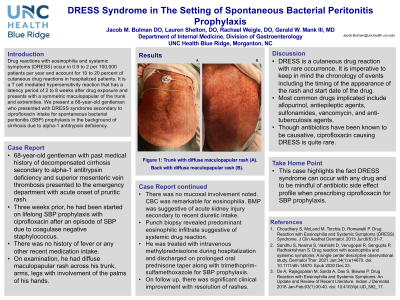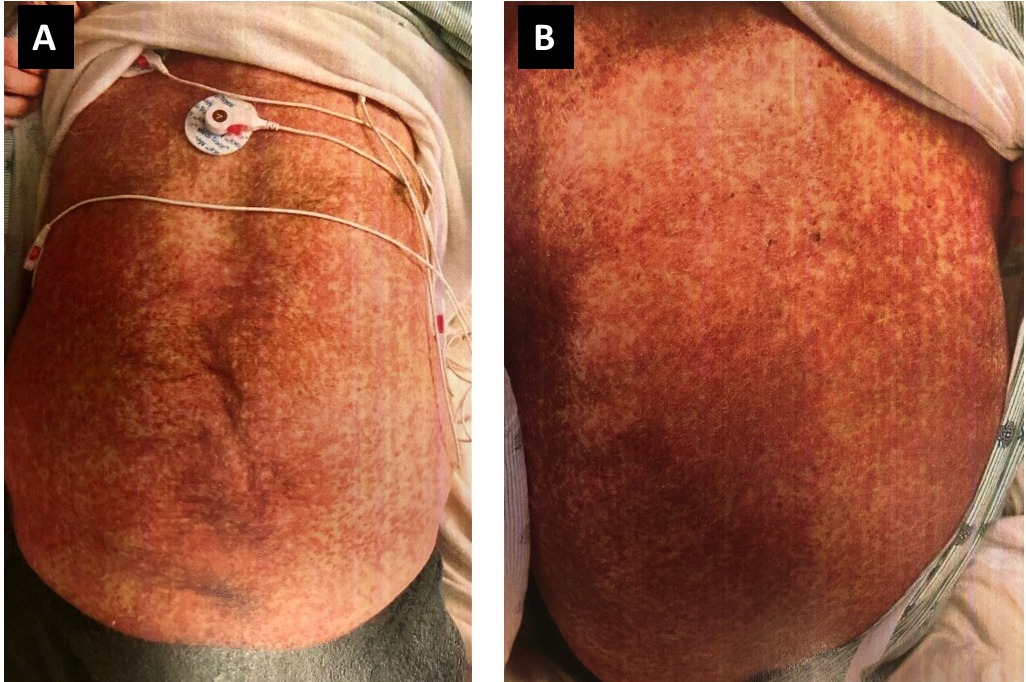Tuesday Poster Session
Category: Liver
P3956 - DRESS Syndrome in the Setting of Spontaneous Bacterial Peritonitis Prophylaxis
Tuesday, October 24, 2023
10:30 AM - 4:00 PM PT
Location: Exhibit Hall

Has Audio
- JB
Jacob Bulman, DO
UNC Health Blue Ridge
Morganton, North Carolina
Presenting Author(s)
Jacob Bulman, DO, Lauren Shelton, DO, Rachael Weigle, DO, Gerald Mank, MD, Suneel Mohammed, MD, Matthew Mishoe, DO, Nathaniel Krogel, DO, Dustin Kilpatrick, DO
UNC Health Blue Ridge, Morganton, NC
Introduction: Drug reactions with eosinophilia and systemic symptoms (DRESS) occur in 0.9 to 2 per 100,000 patients per year and account for 10 to 20 percent of cutaneous drug reactions in hospitalized patients. It is a T cell mediated hypersensitivity reaction that has a latency period of 2 to 8 weeks after drug exposure and presents with a symmetric maculopapular of the trunk and extremities. We present a 68-year-old gentleman who presented with DRESS syndrome secondary to ciprofloxacin intake for spontaneous bacterial peritonitis (SBP) prophylaxis in the background of cirrhosis due to alpha-1 antitrypsin deficiency.
Case Description/Methods: A 68-year-old gentleman with past medical history of decompensated cirrhosis secondary to alpha-1 antitrypsin deficiency and superior mesenteric vein thrombosis presented to the emergency department with acute onset of pruritic rash. Three weeks prior, he had been started on lifelong SBP prophylaxis with ciprofloxacin after an episode of SBP due to coagulase negative staphylococcus. There was no history of fever or any other recent medication intake.
On examination, he had diffuse maculopapular rash across his trunk, arms, legs with involvement of the palms of his hands. There was no mucosal involvement noted. CBC was remarkable for eosinophilia. BMP was suggestive of acute kidney injury secondary to recent diuretic intake. Punch biopsy revealed predominant eosinophilic infiltrate suggestive of systemic drug reaction. He was treated with intravenous methylprednisolone during hospitalization and discharged on prolonged oral prednisone taper along with trimethoprim-sulfamethoxazole for SBP prophylaxis. On follow up, there was significant clinical improvement with resolution of rashes.
Discussion: DRESS is a cutaneous drug reaction with rare occurrence. It is imperative to keep in mind the chronology of events including the timing of the appearance of the rash and start date of the drug. Most common drugs implicated include allopurinol, antiepileptic agents, sulfonamides, vancomycin, and anti-tuberculosis agents. Though antibiotics have been known to be causative, ciprofloxacin causing DRESS is quite rare. This case highlights the fact DRESS syndrome can occur with any drug and to be mindful of antibiotic side effect profile when prescribing ciprofloxacin for SBP prophylaxis.

Disclosures:
Jacob Bulman, DO, Lauren Shelton, DO, Rachael Weigle, DO, Gerald Mank, MD, Suneel Mohammed, MD, Matthew Mishoe, DO, Nathaniel Krogel, DO, Dustin Kilpatrick, DO. P3956 - DRESS Syndrome in the Setting of Spontaneous Bacterial Peritonitis Prophylaxis, ACG 2023 Annual Scientific Meeting Abstracts. Vancouver, BC, Canada: American College of Gastroenterology.
UNC Health Blue Ridge, Morganton, NC
Introduction: Drug reactions with eosinophilia and systemic symptoms (DRESS) occur in 0.9 to 2 per 100,000 patients per year and account for 10 to 20 percent of cutaneous drug reactions in hospitalized patients. It is a T cell mediated hypersensitivity reaction that has a latency period of 2 to 8 weeks after drug exposure and presents with a symmetric maculopapular of the trunk and extremities. We present a 68-year-old gentleman who presented with DRESS syndrome secondary to ciprofloxacin intake for spontaneous bacterial peritonitis (SBP) prophylaxis in the background of cirrhosis due to alpha-1 antitrypsin deficiency.
Case Description/Methods: A 68-year-old gentleman with past medical history of decompensated cirrhosis secondary to alpha-1 antitrypsin deficiency and superior mesenteric vein thrombosis presented to the emergency department with acute onset of pruritic rash. Three weeks prior, he had been started on lifelong SBP prophylaxis with ciprofloxacin after an episode of SBP due to coagulase negative staphylococcus. There was no history of fever or any other recent medication intake.
On examination, he had diffuse maculopapular rash across his trunk, arms, legs with involvement of the palms of his hands. There was no mucosal involvement noted. CBC was remarkable for eosinophilia. BMP was suggestive of acute kidney injury secondary to recent diuretic intake. Punch biopsy revealed predominant eosinophilic infiltrate suggestive of systemic drug reaction. He was treated with intravenous methylprednisolone during hospitalization and discharged on prolonged oral prednisone taper along with trimethoprim-sulfamethoxazole for SBP prophylaxis. On follow up, there was significant clinical improvement with resolution of rashes.
Discussion: DRESS is a cutaneous drug reaction with rare occurrence. It is imperative to keep in mind the chronology of events including the timing of the appearance of the rash and start date of the drug. Most common drugs implicated include allopurinol, antiepileptic agents, sulfonamides, vancomycin, and anti-tuberculosis agents. Though antibiotics have been known to be causative, ciprofloxacin causing DRESS is quite rare. This case highlights the fact DRESS syndrome can occur with any drug and to be mindful of antibiotic side effect profile when prescribing ciprofloxacin for SBP prophylaxis.

Figure: A. Trunk with diffuse maculopapular rash
B. Back with diffuse maculopapular rash
B. Back with diffuse maculopapular rash
Disclosures:
Jacob Bulman indicated no relevant financial relationships.
Lauren Shelton indicated no relevant financial relationships.
Rachael Weigle indicated no relevant financial relationships.
Gerald Mank indicated no relevant financial relationships.
Suneel Mohammed indicated no relevant financial relationships.
Matthew Mishoe indicated no relevant financial relationships.
Nathaniel Krogel indicated no relevant financial relationships.
Dustin Kilpatrick indicated no relevant financial relationships.
Jacob Bulman, DO, Lauren Shelton, DO, Rachael Weigle, DO, Gerald Mank, MD, Suneel Mohammed, MD, Matthew Mishoe, DO, Nathaniel Krogel, DO, Dustin Kilpatrick, DO. P3956 - DRESS Syndrome in the Setting of Spontaneous Bacterial Peritonitis Prophylaxis, ACG 2023 Annual Scientific Meeting Abstracts. Vancouver, BC, Canada: American College of Gastroenterology.
